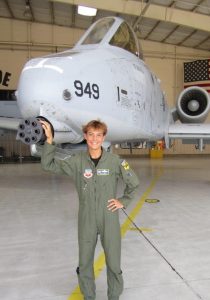When Andra Kniep entered the US Air Force Academy, women were prohibited from flying in combat. Two months before she graduated, the rules were changed and she became the third woman assigned to fly the A-10 attack fighter. Andra was awarded two Distinguished Flying Cross medals on two  consecutive days and joins us as part of our partnership with the Distinguished Service Cross Society.
consecutive days and joins us as part of our partnership with the Distinguished Service Cross Society.
She chose the A-10 because her brother was a West Point graduate and she appreciated the ground support fighter mission. “When you shoot that 30 millimeter Gatling gun there is nothing like it.”
Andra was trained as an Airborne Forward Air Controller. Their role is to take control of the airspace, de-conflict airborne aircraft, communicate with ground controllers and pair aircraft with targets on the ground.
She was deployed as part of the 332nd Air Expeditionary Group in Kuwait as part of Operation Southern Watch. On March 5th, 2002 she was assigned to fly into Afghanistan in support of Operation Anaconda. It took her flight four and a half hours and two aerial refueling stops to get to the target area. Upon arriving at night in the target area, she found friendly forces on one side of a steep ravine and enemy on the other side. Because the target was difficult to spot and the proximity to friendly forces, she tucked in right behind her wingman and guided him to make the first drop on the target. She made a second pass to deploy her weapons. Following the attack they landed in in a blacked out airfield in Pakistan.
The very next day she flew to her target area and, despite being only a Captain, was given responsibility for the entire airspace. She took control of eleven different airborne platforms to make sure there were no “blue on blue” accidents and directed all air support during a very violent battle. The mission ended with Andra helping to keep a “lost” convoy from being engaged by friendly forces.

